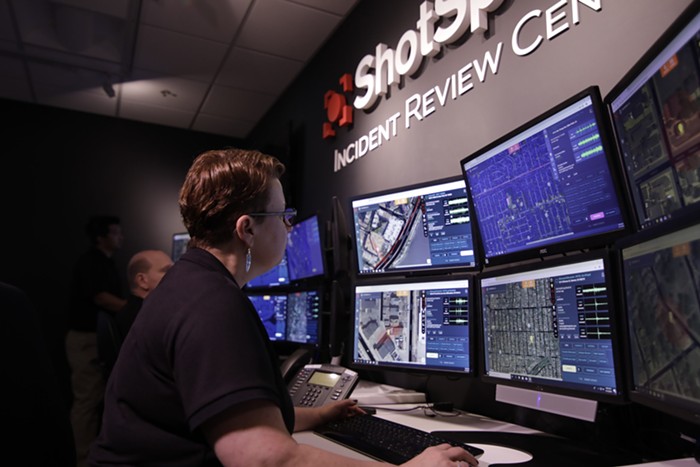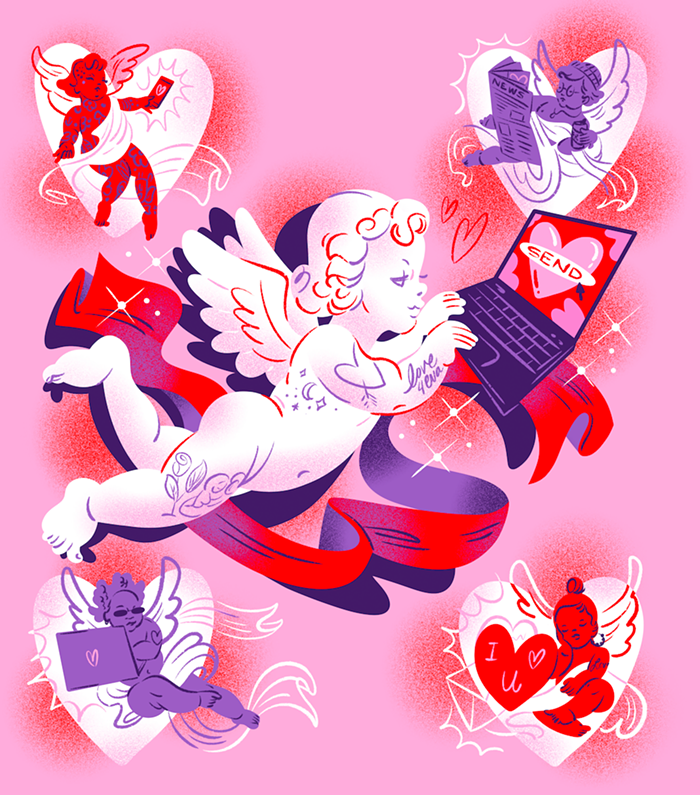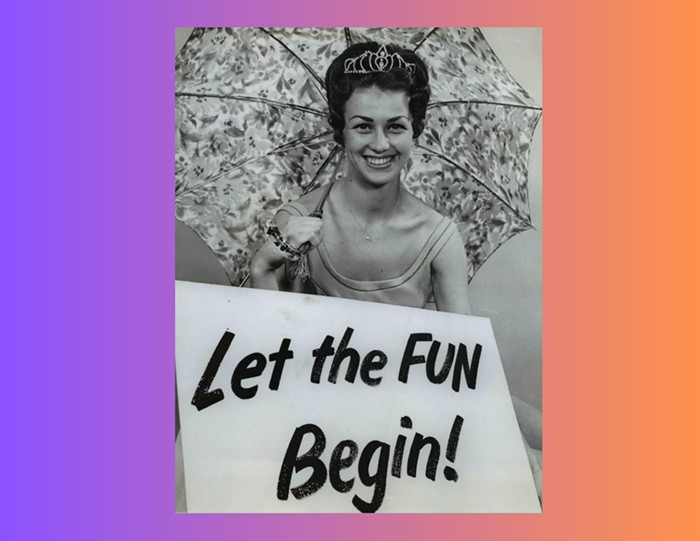In the Portland of the late ’80s and ’90s, there was one publication that influenced and guided the music and arts community more than any other: a free, wildly designed, oversized newsprint magazine called Snipehunt.
Started in 1988 by now-famed poster artist Mike King, the magazine came into its own when contributor Kathy Molloy took the helm a couple years in. During these years, Portland was a very different city: The arts community was small, still finding its footing, and looking to grow.
“I used to beg good bands that I liked to move here,” long-time Portland radio DJ Brandon Lieberman told me. “And back then almost no one wanted to.”
The scene that inspired Snipehunt featured bands that weren’t getting media coverage and writers and artists without an outlet. The magazine soon became a breeding ground for local creators, and its contributor list is a peek at the kind of local talent and energy emerging during that time: novelist and screenwriter Jon Raymond, current Portland city commissioner Chloe Eudaly, filmmaker and installation artist Vanessa Renwick, local writer and publisher Kevin Sampsell, novelist Rene Denfeld, Crap Hound and Liar Town creator Sean Tejaratchi. For many of the contributors, Snipehunt was their first publication, their first opportunity to regularly try out their ideas on an audience.
A typical issue of Snipehunt had interviews with local and national bands, pages of comics from independent artists, scene reports from West Coast cities, oddball prose pieces, political action coverage, and pages of reviews—albums, zines, live shows, films, and books. It was a broad take on DIY culture, loosely based in the punk scene but covering artists and subjects far beyond the imposed limitations of that world.
With the magazine’s history largely absent from the internet, its name unfamiliar to the majority of current Portlanders, and physical evidence of its existence difficult to come by, I reached out to a couple dozen of its contributors to provide me—and the rest of new Portland—with a much-needed history lesson.

Snipehunt in the Community
Filmmaker Vanessa Renwick: You couldn’t wait ’til Snipehunt came out. The paper published so infrequently, and since there was nothing like it at all, when it finally came out it was just bursting at the seams with so many good things inside. It was like someone jumping out of a birthday cake 10 million times. They would just keep coming: these incredible things popping out at you.
Author Jon Raymond: It was amazing how lively it was... an explosion of people and images. I loved the size and the color, the texture of it. It was just an amazing object. And having a big print component of the scene felt kind of glamorous. Like, “look at this multimedia thing happening here. We can do a lot of different things.”
DJ/Writer Ted Thieman: Snipehunt was pretty integral [to the scene]. Kathy had it everywhere—in the record stores, in the clubs. And it was right around the time that X-Ray [Café] was happening. A band would get into Snipehunt and their next show would be packed.
Voodoo Doughnut/X-Ray Café Co-Founder Tres Shannon: Everything was smoke signals and secret passwords back then. And Snipehunt was that smoke signal and secret password. If you got a Snipehunt, you knew what was going on.
Writer Richard Martin: It had a persona to it. Before the word “brand” became a dirty word, it was a good brand. Snipehunt was just cool. And it was just such an original publication. Things that came out after it, like Vice or some of these other sort of irreverent magazines, could never be what Snipehunt was.
Tres Shannon: It had so much information. I mean it would take you fucking three months to read it. By the time you finally got through the whole thing, the next one was available.

Kathy Molloy—The Heart Of Snipehunt
Early on in my interviews, I learned that any history of Snipehunt also had to be a profile of Kathy Molloy. The people I interviewed often talked about Snipehunt and Molloy interchangeably—their relationship to the publication intertwining and shifting with their relationship to her. Even though Snipehunt had hundreds of contributing writers and artists over the years, Molloy and Snipehunt are inseparable. In my interview with contributor and former New Bad Things member Matthew Hattie Hein, he captured what everyone seemed to feel: “I guess the right thing to do is to talk about Snipehunt and not Kathy—but to me they’re the same.”
While the magazine under Kathy maintained the punk-fanzine aesthetic Mike King had established, and stayed generally music-focused, it was just as likely you’d open an issue to a review of the latest Guided by Voices album as you would an article about dismantling the patriarchy. Molloy served as both an arbiter of taste and a moral compass for her community—regularly criticizing the corporate influences seeping into the Northwest DIY community in the wake of early ’90s grunge. As writer Kathleen McConnell noted, “Kathy said Snipehunt wasn’t just about music and documenting music events or music projects. It was about creating a whole way of life.”
Following the end of Snipehunt in late 1996/early 1997, Molloy began cutting people out of her life, and in the early 2000s moved to rural British Columbia. She’s largely managed to keep any evidence of herself off the internet and, of the more than 25 people I spoke with for this story, no one had heard from her in over a decade. I tried contacting her, as did many of those I interviewed, without any luck. While Molloy’s voice is notably absent from this history, everyone I interviewed made sure her presence was felt.

Artist Eliza Tuli Pierson: Kathy always had either bright pink, purple, or blue hair. And she was covered in tattoos, nose piercings. She was very sturdily built; pale skin. You couldn’t miss her. And she wore the most interesting clothing. She’d wear all purple one day. She’d wear a skirt made out of nice silk with a tank top printed for her by a friend, a scarf, and a leather jacket. She had great taste.
Print Artist Alec “Icky” Dunn: She was an awesome person. Really charismatic. Going to clubs with her—I mean, she wouldn’t even have to be on the guest list, she’d just walk in. It was kind of an entourage situation. Drinks were free. You’d go backstage to interview a band and they’d be like, “Who’s this weird lady?”
Richard Martin: She knew exactly what she wanted and what was going to be in Snipehunt, and if it didn’t fit into her world-view it probably wasn’t going in there.
Musician Matthew Hattie Hein: There was a lot of not-doing in Portland in the ’90s. There’s a lot of hanging out on the porch and waking up at noon. I’m certainly guilty of it. I spent a lot of time doing crosswords and smoking cigarettes. The D part of DIY—that’s a very unique feature when I think of what a huge operation [Snipehunt] was. And that lines up with Kathy submitting ideas to [other] zines. Just suggesting: You can do this yourself. Here’s how.
Eliza Tuli Pierson: [Molloy and Snipehunt] gave people the sense they could do something that would be taken seriously if they took themselves seriously—because Kathy had such a work ethic. And she was tough on people if they were flaky. She was like, “You say you’re going to do this, so you better show up, you better do it, you better be there.” She was a very intense person. But people became really motivated around her, because you couldn’t resist her energy.
Portland Commissioner Chloe Eudaly: My fondest memories of Kathy are as a hub for so many people. Whether it was people in Portland or the West Coast or the entire country who were involved in similar efforts—indie bands, DIY publishing, visual art—they came together around her. She wasn’t the most nurturing person, so I don’t think I’d call her a “mother hen,” but she did bring people together. And those figures are kind of rare. She had a huge impact.
Eliza Tuli Pierson: She was like a politician. Not in a full-of-shit way, but she just had this way of connecting with people. You felt like what she was doing was important and she made you feel important. She was like the punk mayor of Portland.
Writer Ana Helena: I ended up being kind of Kathy’s personal servant. I think that’s why she was a goddess, because she could make you serve her. Everyone around her.

How it Worked
The Snipehunt office was initially in Kathy’s rental house in the Woodlawn neighborhood of Northeast Portland, but relocated when she bought a home a few miles away on Albina Avenue, where Atlas Tattoo is located today. The entire main floor of the house was dedicated to producing Snipehunt, and its always-open door made it a community hub.
While finding circulation numbers for Snipehunt isn’t easy, Molloy noted in her introduction to a 1992 issue that she’d made 7,000 copies, and in 1994 mentioned it was up to 13,000. Given that issues from 1995 and 1996 are the ones I came across most often in archives and people’s collections, it’s likely that its circulation kept growing until the end. While these aren’t huge numbers in terms of local magazines or newspapers, they’re impressive when you consider it was a magazine without a formal distribution system being run out of a living room.
“We’d get them delivered and it would take up the whole front room,” Dunn told me. “There would just be stacks and stacks.”
To most people, Snipehunt probably wouldn’t look much different than today’s average alt-weekly: It’s slightly bigger, folds horizontally across the middle, and has a more playful aesthetic. But it managed to pack more in with far fewer ads. Today, for something similar to be free, it would almost certainly be funded by Red Bull, or at least littered with as many ads as articles. Part of what makes Snipehunt so impressive now is the ambition: It was giant, filled with voices, free, and produced without a parent company, board of directors, editorial team, or corporate ad dollars.
Writer Fred Landeen: Going to her compound was always surprising. You’d always see someone you knew from Satyricon or from a band or from another zine. They’d stopped in to drop something off and she’d put them to work. They’d be gluing bits of paper to the layout sheet or trying to typeset something on an early Mac. There were little bits of paper everywhere. Everywhere. They were stuck on the floor, ceiling, walls.... Every surface had little cut marks from where an X-ACTO knife had gone through a page or off the edge of some cardboard. There were spray-painted stencils and screen-printed things. Everything was a visual riot of color and bits of paper. If you dropped your contact lens in there, forget it.

“Going to her compound was always surprising. You’d always see someone you knew from Satyricon or from a band or from another zine. They’d stopped in to drop something off and she’d put them to work. They’d be gluing bits of paper to the layout sheet or trying to typeset something on an early Mac. There were little bits of paper everywhere. Everywhere.”—Fred Landeen
Kevin Sampsell: It seemed kind of ramshackle. Not in a bad way, but because that’s the way it was in 1991 to ’93. I just brought my reviews in on paper, or maybe a floppy disc, and she put them on her computer. I can’t remember. It was right around the cusp of when people started using email. I don’t really remember any sort of editing going on.
Ana Helena: When the magazine was close to publication, it was a frenzy. Everyone working at all hours. We all learned layout. It was like journalism class every three months.
Graphic Artist Sean Tejaratchi: It was quarterly, so every couple months there would be this flurry of activity and all these people would sort of coalesce—come out of the woodwork and do their thing, then part ways and come back for the next one. People and bands from out of town would always stay with her, and she would often involve them in the assembly. There were a lot of guest creators. So it was a social as well as a practical thing.
Artist Dwayne Hedstrom: When the magazine came out, we’d drive up the I-5 corridor [from Vancouver, B.C., to San Francisco], dropping it off in places like Mount Vernon, Bellingham, Everett... wherever there was a weird record store in a small town.
Ana Helena: [When a new issue came out] I’d drive [Molloy] to the post office and she’d send Snipehunt to people all over the world. She’d be like, “Oh man, they’re so far away and so cut off from civilization. They have no idea what’s going on.” It was like her love letter to the world.
Through the Oregon Historical Society, I came across the paste-ups for Snipehunt—the home-assembled master copies that would be sent to the printer. While in some ways the paste-ups revealed it to be more humble than the printed version let on, they also showed the sheer amount of physical labor that went into a single issue—remnants of hot wax and X-ACTO knife debris cling to the pages, and each issue contains spreads with multiple transparency overlays marked with Post-It notes indicating color gradients.
Among the paste-ups, I found a half-sheet form Molloy had created for putting an issue together. On it, there were the names of nearly 60 contributors, the name of their article, column, comic, or department, each of their respective phone numbers, and whether they’d submitted their piece yet. This small piece of paper was more telling than the paste-ups themselves: Snipehunt may have been ramshackle, but it was a huge operation. As Helena put it, “Snipehunt was a volunteer effort. But it was the king of the volunteer efforts.”

A Platform
Snipehunt was rare in that it was a magazine with a wide and ever-growing audience that always gave new writers and artists a chance. Some of this was simple economics: Molloy had a lot of space to fill and was unable to pay anyone aside from the occasional cover artist. But Snipehunt fostered a community of people who otherwise wouldn’t have come together and, in many cases, helped launch their careers.
Jon Raymond: [From the outside] it felt like a circus. But it was pretty easy to find your way into that world. I came back here from college in ’94. By that time most of my friends were deep into the music world, but I was more in a writing mindframe. And Snipehunt was just one of the most easily accessible places to do anything.
Ana Helena: It definitely gave me a platform that I never had access to before... like interviewing Team Dresch. Just being like, “I’m writing for Snipehunt, I want to do an interview. Can we do this?” And then being put on the front cover of a highly anticipated quarterly magazine—[my] interview with my favorite band at the peak of their game.
Kevin Sampsell: They were the first magazine I wrote for. And it was just exciting to get my name in print somewhere and get a chance to write about books and music.

Chloe Eudaly: It was my first experience having my writing published. I’ve kind of forgotten after 30 years that that’s a big deal... but it is.
Matthew Hattie Hein: We learned so much from Snipehunt because it was kind of professional. It actually had deadlines and a distribution network, and columns and departments, like a weekly magazine.
Sean Tejaratchi: If I hadn’t been involved in Snipehunt I would’ve never done Crap Hound. Well, I don’t know about never... but Crap Hound was a direct result of working on it. Just realizing that, “Oh, this is accessible and anyone can do it.” If a bunch of fucking people in bands can get together and create this publication every two-and-a-half months, I can do my thing without too much effort or money. So it was a huge thing personally, even though I wasn’t involved in the music scene directly.
Jon Raymond: It’s actually really embarrassing reading some of the things I wrote for Snipehunt. They were politically in a good place—I was writing about gentrification, renter’s rights, and stuff like that. But it was really pretentious cultural criticism, kind of pseudo-academic articles. They didn’t care, I could do whatever. I was really against music at that time, just because everyone I knew was just purely music, and I thought something else was being underrepresented. So my stuff was really highbrow in its aspirations—it makes me cringe looking at them now. But I was learning.
Even as a music nerd who grew up immersed in the Northwest music scene, my favorite moments of Snipehunt are the articles that have nothing to do with music. It held so many oddball pieces of writing that wouldn’t make sense in an alt-weekly, a literary journal, or even most zines.
Vanessa Renwick’s jarring prose piece about attending a seatbelt class and being shown a slideshow of car wrecks and bodies; Tres Shannon’s article about traveling to Super Bowl XXX; Curt Schultz’s semi-apocryphal history of Pez and Pez dispenser obsession; Jennifer Gleach’s “Crush Corner” column which approached the concept of the crush as a playful philosophical challenge; dishwasher Pete Jordan’s “Regular Folks” article about meeting people on his pilgrimage to wash dishes in all 50 states. These are the kinds of things that now seem so wonderfully strange, full of life, and maybe only possible in the pages of Snipehunt.
Ending and Disappearing

In early 1997, Molloy and crew put together a final farewell issue of Snipehunt. Dozens of writers submitted pieces, artists submitted art, and advertisers placed their ads. The whole issue was laid out—but it never went to print. No one was sure if there was a lack of money, or if Molloy was just burnt out, but it was soon clear to everyone involved that there wasn’t going to be a big announcement or a send-off party. Snipehunt was just over.
Looking back at Molloy’s “My Eye” column suggests the magazine’s ending had been coming since the beginning—a years-long accumulation of factors that began adding up when the Northwest became a place of national media attention in the early 1990s.
In a 1995 issue, a year or so into being a homeowner, Molloy writes about suddenly not being able to relate to Snipehunt readers.
“I worry about money for experimental plumbing, not experimental music,” she writes. “I guess it’s my reaction to these modern times, when every 14-year-old with braces has green hair and plays drums in a rock band. Being weird is the norm. Party’s over, time to pay property tax.”
And in the second-to-last issue of Snipehunt, in spring of 1996, she wrote possibly the closest thing to a farewell that Snipehunt readers would get.
“It’s not enough anymore to tell people what kind of music they should listen to,” Molloy wrote. “I want to tell people how they should live their lives. Information that is useful like where to buy your food, how to fix your bicycle, and how to make the first move and still smash the patriarchy. Real life matters, not rock journalism.”
Soon after, Molloy began to change. Again and again, people told me that one day she was one of their best friends and the next she wasn’t. If it was someone she wasn’t particularly close with, she just stopped talking to them. But most of her close friends she cut off after minor indiscretions—a pile of stuff left in her basement, a comment at a party.
“When Kathy left, it was kind of a scorched earth situation,” Eudaly said. “A lot of us were left a little bewildered by what had happened. And we missed her and missed the sense of community she created for us.”

A snipe hunt is a prank. A search for a creature that doesn’t exist. I think of the magazine as being a snipe hunt for elusive bits of the underground, or of a particular way of life. Every find is a clue, a piece, but there’s ultimately no snipe—as soon as you arrive at the best underground artist or band, the mainstream absorbs them. As soon as you get one piece of your ideal life in place, another part breaks.
As I was working on this, a friend pointed out that my attempt to write a history of Snipehunt had become a snipe hunt for Kathy Molloy. When I started, I had no idea how impossible it would be to untwine Molloy from Snipehunt; it was such a huge publication, I never imagined one person could have so much influence over it. But I felt a partial history was better than no history at all. So I kept going, hoping that publishing this would bring her out of hiding long enough to say that a Snipehunt history is incomplete without her, that I was a fool to try, and that—before disappearing again—she would set the record straight.
Author’s note: Many of the people who helped get the facts straight for this story didn’t make it into the piece. Some of the unheard voices include: Sam Coomes, Charles R. Cross, Peter Jacobson, Pete Jordan, Mike King, Fiona Smyth, and Lindsey Thrasher. Also, big thanks to Chloe Eudaly, Vanessa Renwick, and Kevin Sampsell for helping connect the Mercury with so many of the people who made this piece possible.












